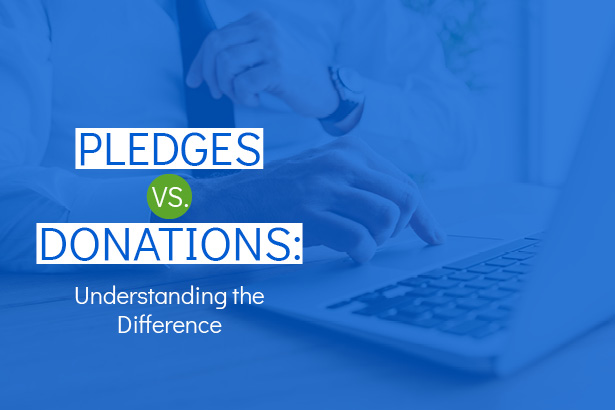
Organizations that rely on donations to continue serving their communities or participants, whether they are nonprofits, schools, or sports teams, must focus on providing high-quality donor experiences. When you deliver an experience that makes donors feel good about contributing to your cause, you could see a significant increase in retention rates. Prioritizing donor retention will ultimately build a dedicated pool of supporters who will lend support any time you need it.
One way to cultivate positive donor relationships that increase retention is to choose fundraising ideas and donation methods that engage your audience. For example, if you direct a marching band and plan to launch a campaign, it makes more sense to choose an idea like a practice-a-thon rather than a baseball hit-a-thon.
But how can you make sure the act of donating is both easy for donors and maximizes results for your organization? In this guide, we’ll distinguish between two popular donation types so you can choose the best one for your unique needs:
- Defining Pledges and Donations
- Pledges vs. Donations: Pros and Cons
- Best Practices for Managing Pledges
Before deciding which donation type to solicit, your organization must have a clear understanding of what these terms mean as well as the benefits (and drawbacks) of each type. First, let’s get back to basics and define each donation type.
Defining Pledges and Donations
When it comes to types of donations, there can be some overlap between the various categories. Here are simple definitions of and key differences between pledges and donations:
- Pledges. A pledge is a promise to pay a certain amount of money to an organization at a later date. For example, you might gather pledges during the first round of an end-of-year mobile campaign and allow donors to give the money later on.
- Donations. This refers to any gift given to your organization. They are commonly financial gifts, but supporters may also give goods or services. This term typically has some kind of qualifier attached to it. For example, are you soliciting monthly, recurring donations from donors, or collecting legacy donations from a donor who has passed away? Both are considered donations, but they occur for different reasons, within different contexts.
Because there are so many types of donations, we’ll focus on comparing pledges and one-time donations. A supporter makes a one-time donation when they give a specific monetary amount to an organization just once. In this case, the money is given to the organization immediately.
Some fundraisers are better suited to one gift type over the other. A fun run is a great way to collect pledges because supporters can pledge a certain amount for each mile participants run. On the other hand, a crowdfunding campaign that will fund some urgent need should solicit simple one-time donations instead.
Pledges vs. Donations: Pros and Cons
Anytime your organization needs to choose between two options, it can be helpful to create a list of pros and cons. If you’re trying to decide whether to use pledges or donations, it can feel overwhelming to think through the ways each donation type can impact your donors.
To ensure you follow a strategy that will help you steward donors, here are the top pros and cons to consider for each donation type:
Pledges
The pros of the pledge model are that:
- It is versatile. You can apply this model to almost any fundraiser. It’s especially easy when it has some kind of metric to base pledges on. For example, if you hold a charity race, you might ask supporters to pledge donations based on the number of miles or kilometers participants run.
- Donors can give more. Because donors don’t have to pay the gift in full at the time of the pledge, they can afford to give more by breaking down large sums into smaller payments.
- Increased event attendance. Let’s return to our race example. If supporters pledge donations to a participant based on how many miles they run, they’ll likely want to watch that participant’s performance. Because donors have a vested interest in individual participants, they’re more likely to attend the event (and contribute to any side fundraisers, like food and merchandise sales!).
On the other hand, there are a few cons of this method to consider, including:
- Tracking and managing many pledges can be difficult.
- Your organization will need to follow up with the donor to collect the pledges and/or any future installments.
- There is a chance donors could miss or skip payments, leaving your organization without the funds it needs.
Donations
One-time donations have their own set of unique pros and cons. The positive components include:
- Immediate access to funding. When a donor makes a one-time donation, they make the payment to your organization. This makes these donations ideal for any urgent needs or campaigns with short timelines.
- Simplified transactions and follow-up. Your organization won’t need to spend time managing a host of pledges, payment deadlines, and reminders. Instead, you’ll simply accept one donation per donor and will only need to send donation receipts and thank-you messages.
- Stronger appeal to new supporters. A first-time donor may not feel as comfortable committing to pledges, especially if they’ll be paying monthly installments. But, the ease and lack of commitment associated with one-time gifts are the perfect way for them to test out engaging with your organization.
One-time donations also have a few disadvantages you should carefully consider:
- Donors will have to make donations they can afford to pay at once, in full. This can limit how much they are able to donate.
- You’ll have more limited opportunities (usually just one or two) to engage with donors.
- It can be harder to ask for continued support, especially if donors make a large one-time gift.
It’s up to your organization to decide how much these pros and cons matter to you (and to your donors). If your top priority is quick access to funds, it’s best to stick to traditional, one-time donations. On the other hand, if you are okay with waiting if it means months of sustainable funding, pledges will work best.
Best Practices for Managing Pledges
One of the most challenging parts of optimizing the donation process is managing individual donations and follow-up. With pledges, this workload can quickly grow and become unmanageable.
To overcome this obstacle, follow these top best practices:
- Invest in a fundraising platform. Look for a platform that specializes in collecting and organizing pledge donations. In this directory of fundraising platforms, 99Pledges suggests an affordable tool without any platform or startup fees.
- Maintain regular communication. Set up a specific follow-up or reminder cadence so you are always in contact with the pledging donor. For example, you might follow up to remind them that their payment is due in one week, send a second message on the due date, and, for late payments, follow up with additional reminders as needed. Don’t forget to thank them once they submit the payment!
- Recognize impactful donors. Make sure to recognize donors who go above and beyond during your pledge fundraiser, just like you would any other campaign. If the donor is comfortable with it, recognize them publicly after the fundraiser wraps up. This shows that you value their support and can encourage them to participate in future pledge fundraisers.
Keep in mind that pledge attrition, or backing out of delivering on promised pledges, can happen to any organization. Be prepared to lose a small percentage of your funds to pledge attrition.
You can limit the impact of pledge attrition by ensuring you have a strong follow-up strategy outlined. While communication won’t help in situations that are outside of your control (e.g., a donor faces financial hardship and can no longer afford to donate), it can prevent supporters from simply forgetting about the payment.
When you choose the right donation type for your donors and fundraiser, you’ll be able to cultivate relationships with donors and develop a trusting partnership with them. While there are general benefits and disadvantages to both pledges and donations, keep your organization’s specific needs at the top of your mind when making a decision. Consider how the fundraising method you choose could inform the donation type you want and select the one that aligns best with your campaign.
Author: Brad Dowhaniuk
 Brad Dowhaniuk is the co-founder of 99Pledges, which provides schools and teams with an easy-to-use, web-based fundraising solution to manage and drive success in Fun Runs, jog-a-thons, baseball hit-a-thons, and much more.
Brad Dowhaniuk is the co-founder of 99Pledges, which provides schools and teams with an easy-to-use, web-based fundraising solution to manage and drive success in Fun Runs, jog-a-thons, baseball hit-a-thons, and much more.

















 I can’t wait to meet with you personally.
I can’t wait to meet with you personally.
Comments on this entry are closed.